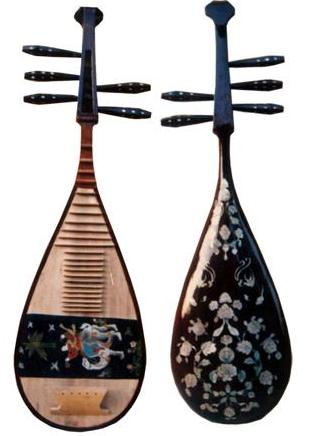The structure and shape of the five-stringed pipa
At the turn of the Han and Wei Dynasties, musicians from the Western Regions brought the five-string pipa. Its shape is similar to the four-string pipa. The resonance box is mostly half-pear-shaped. There are ten frets on the panel. Three right two.

The strings use silk strings, the two outer strings use substrings (the same tuning is also used), and inwards are the middle strings, the old strings, and the winding strings. The five-stringed pipa was popular in the Sui and Tang Dynasties. The five-stringed pipa of the Tang Dynasty was made very elegantly, with leather or tortoiseshell flakes glued to the panel, inlaid or painted with various ornaments or patterns.
The five-stringed pipa has many shapes and styles, with straight necks and curved necks, and speakers with semi-long pear-shaped, semi-circular pear-shaped, flat plum blossom-shaped and flat rounded ones.
Quxiang and half-length pear-shaped speakers are the earliest forms of five-stringed strings. The tortoise plate gradually shrinks to the mountain pass and is in the shape of a long pear that is cut open. It is often seen in early Dunhuang murals. The left hand holds the qin to press the strings, and the right hand holds the tortoise plate on the right shoulder and plays with the plectrum. In the frescoes of the Mogao Grottoes in the Tang Dynasty, the speakers with a semicircular pear-shaped five-string are more common.
The five-stringed pipa in the flat plum blossom-shaped speaker in Cave 220 of the Mogao Grottoes is unique. The speaker resembles a petal, the neck is thin and long, and the head is bent backwards. The flat and round five strings of the speaker are like Ruan Xian, but the back is made of whole wood, and the center of the panel is painted with a rectangular pattern.
 渝公网安备 50010702504639号
渝公网安备 50010702504639号